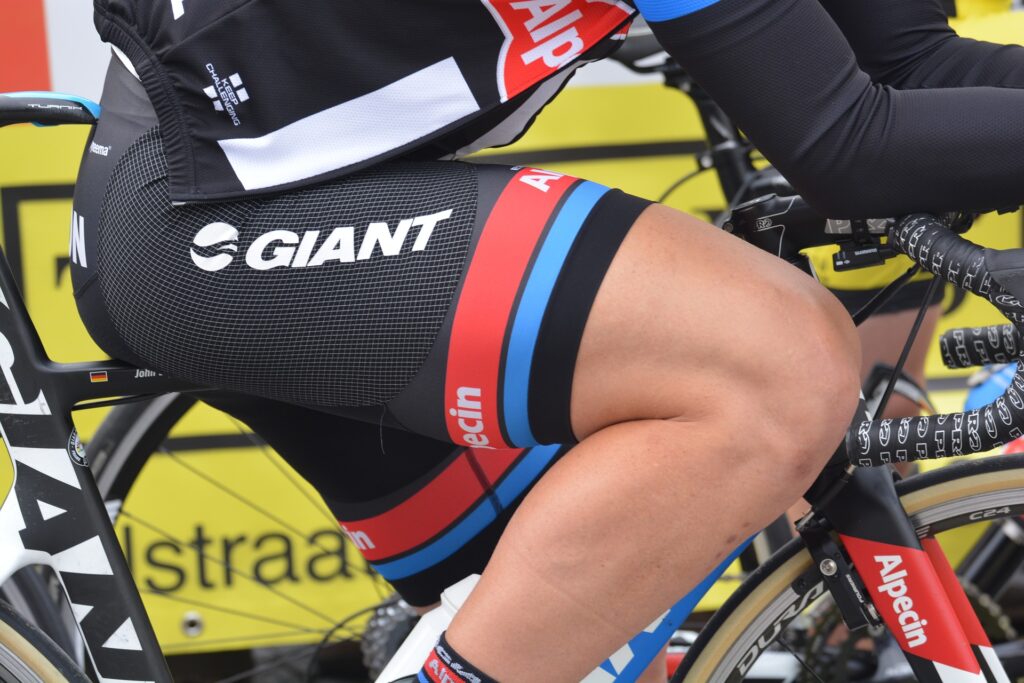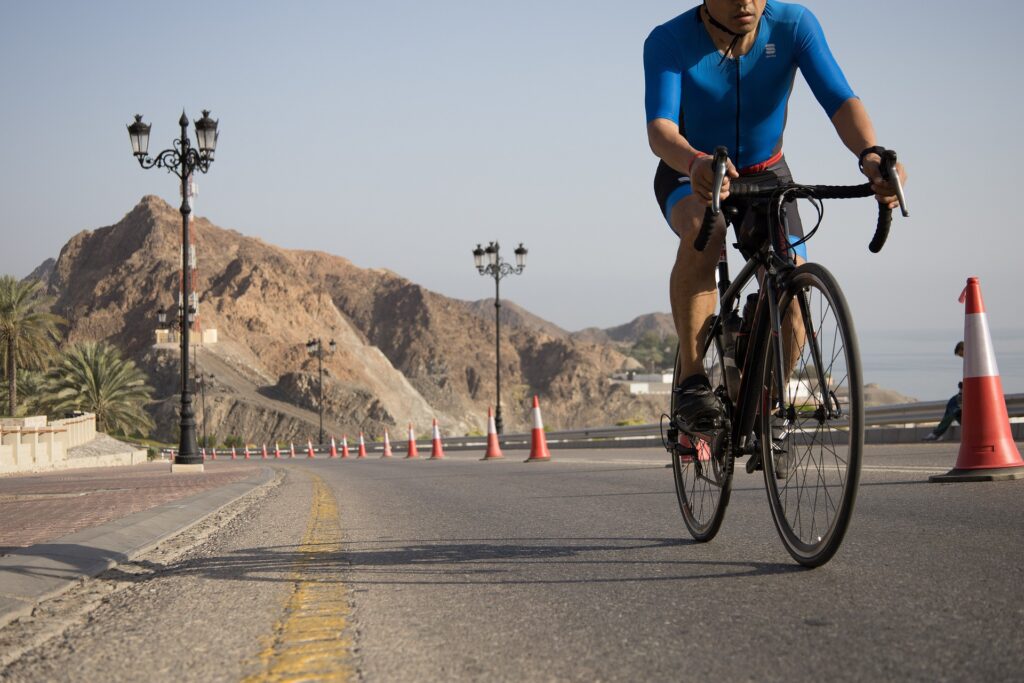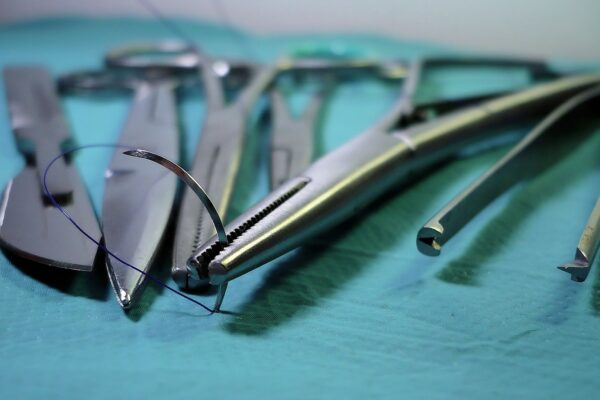How Men Can Lose Stubborn Thigh Fat. Complete Diet and Exercise Plan to Get Fast Results

When it comes to body fat, the thighs can be a frustrating problem area for many men.
Those excess inches not only make finding the right pair of jeans a daunting task, but they can also have an impact on self-confidence and overall health.
But fear not, as we delve into the secrets of banishing thigh fat and regaining control over your lower body. Thigh fat is a common concern among men seeking to achieve a leaner and more sculpted physique (1). While excess fat accumulation in the thighs can affect both genders, men tend to store fat in this area differently due to hormonal and genetic factors.
Men often face unique challenges when trying to shed thigh fat, as it tends to be stubborn and resistant to traditional weight loss methods.
However, with the right strategies and a commitment to a healthy lifestyle, men can effectively reduce thigh fat and achieve their desired leg shape.
This article aims to provide men with effective strategies to tackle and eliminate thigh fat.
We will explore a comprehensive approach that combines a healthy diet, targeted exercises, lifestyle modifications, and tracking progress. By following these strategies, men will be equipped with the knowledge and tools necessary to get rid of thigh fat and attain leaner, more sculpted legs.
Understanding Thigh Fat
Thigh fat refers to the accumulation of excess adipose tissue in the thigh region, which can affect both men and women. The distribution and amount of thigh fat can vary among individuals due to factors such as genetics, hormones, and overall body composition. (2)
When it comes to thigh fat, it is important to differentiate between two primary types: subcutaneous fat and visceral fat.
Subcutaneous Fat
This is the fat that lies directly beneath the skin in the thigh region. It is the visible fat that can be pinched and measured.
Subcutaneous fat is a storage depot for excess calories, and its accumulation can vary based on genetics, hormones, and overall body composition. While subcutaneous fat can affect the appearance of the thighs, it is generally considered less harmful to health compared to visceral fat.
Visceral Fat
Unlike subcutaneous fat, visceral fat is located deeper within the abdominal cavity, and surrounding organs such as the liver, pancreas, and intestines.
Although not directly visible, excess visceral fat has been linked to various health risks, including cardiovascular disease, insulin resistance, and metabolic disorders. While visceral fat is not specific to the thighs, an overall reduction in body fat can contribute to a decrease in visceral fat levels.
Factors Contributing to Thigh Fat
Accumulation in Men
Thigh fat accumulation in men can be influenced by various factors. While genetics and hormonal differences play a role, there are other contributing factors to consider:
Hormonal Balance
Hormonal imbalances, such as lower testosterone levels and higher estrogen levels, can contribute to thigh fat accumulation in men. Testosterone promotes muscle development and fat burning, while increased estrogen levels can promote fat storage in the lower body.
Sedentary Lifestyle
Leading a sedentary lifestyle with minimal physical activity can lead to overall weight gain, including thigh fat accumulation. Lack of regular exercise decreases calorie expenditure and can result in increased fat storage in the thigh area.
Poor Diet
Consuming a diet rich in calories, unwholesome fats, and processed foods can underwrite to extra fat growth, within the thighs also. Consuming more calories than the body needs leads to weight gain and can contribute to thigh fat.
Stress and Cortisol Levels
Chronic stress can lead to elevated cortisol levels, which can promote fat storage, particularly in the abdominal and thigh areas.
High levels of cortisol can hinder weight loss efforts and contribute to thigh fat accumulation. Thigh fat can cause several health issues also, which you should be aware of in the meantime.
So, you can get rid of that and protect yourself from those risks. Here are a few given to you.
- Insulin resistance and type 2 diabetes: Excessive thigh fat has been linked to insulin resistance, a condition where cells become less responsive to insulin, leading to high blood sugar levels. Insulin resistance is a precursor to type 2 diabetes and can increase the risk of developing the disease.
- Reduced mobility and joint issues: Carrying excess weight in the thighs can put a strain on the joints, leading to discomfort and increased risk of joint problems such as osteoarthritis. This can impact mobility and overall quality of life.
Creating a Healthy Diet Plan
A healthy diet plan is crucial for achieving successful weight loss and reducing thigh fat.
Maintaining a balanced diet is essential for achieving overall weight loss, including reducing thigh fat. A balanced diet provides the body with the necessary nutrients while creating a calorie deficit for weight loss.

By including a variety of foods from different food groups, such as fruits, vegetables, whole grains, lean proteins, and healthy fats, a balanced diet ensures that the body receives essential vitamins, minerals, and antioxidants. This promotes optimal functioning of the body, supports muscle growth and repair, and provides sustained energy levels.
A balanced diet helps control hunger and cravings, making it easier to adhere to a calorie deficit and sustain long-term weight loss success. A healthy diet makes you to lose numbers of pound in a month.
Energy Intake vs. Energy Expenditure
A crucial aspect of any successful weight loss journey, including the reduction of thigh fat, is the establishment of a caloric deficit.
This concept revolves around understanding the balance between energy intake and energy expenditure.
Energy Intake
Energy intake refers to the number of calories consumed through food and beverages. It is important to be aware of the types and quantities of food consumed to effectively manage weight.
A balanced diet, consisting of nutrient-dense foods, helps provide the necessary energy and nutrients for the body’s functions while supporting weight loss goals.
Energy Expenditure
Energy expenditure refers to the number of calories burned by the body through various activities, including basal metabolic rate (BMR), physical activity, and the thermic effect of food.
BMR represents the energy required for essential bodily functions at rest, such as breathing and maintaining body temperature. Physical activity includes both structured exercise and daily activities like walking, cleaning, or gardening.
The thermic effect of food is the energy used by the body to digest, absorb, and metabolize food (3).
Caloric Deficit
To lose weight and reduce thigh fat, creating a caloric deficit is necessary. This means that the energy expended must exceed the energy consumed.
When the body is in a caloric deficit, it taps into its stored fat reserves to obtain the energy it needs, resulting in weight loss. Gradual and sustainable weight loss is often achieved by aiming for a moderate caloric deficit of around 500-1000 calories per day.
This can be achieved through a combination of dietary modifications, portion control, and increased physical activity.
Principles of a Thigh Fat-Targeted Diet Plan
When developing a diet plan specifically targeting thigh fat reduction, several key principles can be incorporated for optimal results.
Emphasizing Whole Foods and Lean Protein Sources
Focus on consuming whole foods such as fruits, vegetables, whole grains, and lean protein sources like chicken, turkey, fish, tofu, and legumes. These foods are rich in nutrients, low in calories, and provide essential amino acids for muscle growth and repair.
Limiting Refined Sugars and Processed Foods
Minimize or avoid foods high in refined sugars, such as sugary drinks, pastries, and desserts.
Additionally, limit processed foods that often contain added sugars, unhealthy fats, and preservatives.
These foods can contribute to weight gain and hinder thigh fat reduction.
Incorporating Healthy Fats and Complex Carbohydrates
Include sources of healthy fats like avocados, nuts, seeds, and olive oil.
Healthy fats provide satiety, support hormone production, and assist in nutrient absorption.
Similarly, opt for complex carbohydrates such as whole grains, sweet potatoes, and quinoa, which provide sustained energy and fiber.
Proper Portion Control and Meal Timing
Practice portion control to ensure you’re consuming an appropriate amount of calories for your goals. Be mindful of serving sizes and avoid overeating. Additionally, consider meal timing strategies, such as spreading meals throughout the day to support metabolism and provide a steady flow of energy.
Effective Exercises for Reducing Thigh Fat
Exercising plays a crucial role in reducing thigh fat and achieving leaner legs.
It not only burns calories but also helps to build muscle, improve overall body composition, and increase metabolism. Here are the keyways exercise contributes to reducing thigh fat:
Caloric Expenditure: Engaging in aerobic exercises, such as running, cycling, or brisk walking, increases your heart rate and burns calories.
This energy expenditure creates a caloric deficit, which is essential for overall weight loss, including thigh fat reduction.
Muscle Development: Resistance training exercises, such as squats, lunges, and leg presses, target the muscles in the thighs. These exercises stimulate muscle growth and development, which can contribute to toning and shaping the thighs.
As you build lean muscle mass, your metabolic rate increases, leading to enhanced calorie burning even at rest.
Spot Toning Myth: While it’s not possible to spot-reduce fat from specific areas of the body, including the thighs, exercise helps in reducing overall body fat.
As you consistently engage in cardiovascular and resistance exercises, your body will gradually reduce fat stores throughout, including the thigh area.
Consistency and Variety: Consistency is key when it comes to exercise and thigh fat reduction.
Aim for a balanced exercise routine that includes both cardiovascular exercises and strength training.
Additionally, incorporating different exercises and workout variations can help prevent boredom, maintain motivation, and ensure all muscle groups in the thighs are targeted.
Consuming an appropriate number of calories for your goals. Be mindful of serving sizes and avoid overeating. Additionally, consider meal timing strategies, such as spreading meals throughout the day to support metabolism and provide a steady flow of energy.
Special Exercises for Losing Thighs
Squats and Lunges
Squats and lunges are compound exercises that target multiple muscles in the lower body, including the thighs.
Squats primarily work the quadriceps, hamstrings, and glutes, while lunges engage the quads, hamstrings, and glutes along with the stabilizing muscles (4). These exercises help build strength, increase muscle tone, and burn calories, contributing to thigh fat reduction.
Leg Presses and Leg Curls
Leg presses and leg curls are resistance exercises commonly performed using machines at the gym.
Leg presses mainly target the quadriceps, hamstrings, and glutes, while leg curls primarily focus on the hamstrings. These exercises help build muscle strength and improve muscle definition in the thighs.
Cycling and Running
Cycling and running are cardiovascular exercises that engage the muscles in the lower body, including the thighs.

These activities are effective for burning calories and promoting overall fat loss, including thigh fat.
Cycling can be done outdoors or on a stationary bike while running can be performed outdoors or on a treadmill. Both activities can be adjusted in intensity and duration to suit individual fitness levels.
Walking or Biking Instead of Driving
Choosing to walk or bike instead of relying on driving can significantly contribute to burning calories and reducing thigh fat. Walking is a low-impact aerobic exercise that can be easily integrated into daily routines.
Biking, whether it’s commuting or leisure cycling, provides cardiovascular benefits and targets the muscles in the legs, including the thighs.
By incorporating walking or biking as transportation alternatives, you can increase physical activity levels and promote thigh fat reduction.
Taking the Stairs Instead of the Elevator
Opting for the stairs instead of the elevator whenever possible is an excellent way to add physical activity to your daily routine.
Climbing stairs engages the muscles in the legs, including the thighs, and helps increase cardiovascular fitness. Regular stair climbing can contribute to calorie burning and the toning of thigh muscles over time.
Wrap Up
In conclusion of this article, it requires consistency, patience, and dedication is key throughout the process. It is important to stay committed to a balanced diet and exercise regimen, understanding that results take time.
Incorporating active lifestyle habits such as walking or biking instead of driving and taking the stairs instead of the elevator can increase daily physical activity levels and further contribute to thigh fat reduction.



